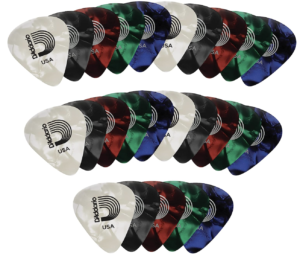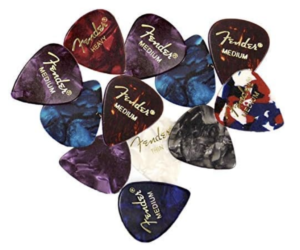 Different guitarists have unique preferences and playing styles. However, some factors can help determine what makes a great pick. Here are some aspects to consider when searching for the best guitar pick.
Different guitarists have unique preferences and playing styles. However, some factors can help determine what makes a great pick. Here are some aspects to consider when searching for the best guitar pick.
- Material: Guitar picks come in various materials, such as plastic, nylon, celluloid, metal, and more. Each material has its characteristics, affecting tone, grip, and durability. Common choices include standard plastic picks for versatility, nylon for a warmer tone, and metal picks for a bright, clear sound.
- Thickness: Picks come in different thicknesses, usually measured in millimeters (mm). Thinner picks are more flexible and suitable for strumming and acoustic playing, providing a mellower tone. Thicker picks offer more control and precision, making them ideal for lead playing and heavy strumming.
- Shape: Guitar picks come in various shapes, including standard teardrop, jazz, triangle, and more. The shape can impact how the pick feels in your hand and how it interacts with the strings. Experimenting with different shapes can help find one that suits your playing style.
- Grip: Look for a pick with a texture or grip surface that provides a secure hold while playing. Some picks have ridges, indentations, or matte finishes to enhance grip and prevent slippage.
- Tone: The material, thickness, and shape of the pick can influence the tone produced. Experimenting with different picks can help you find the one that complements your preferred playing style and desired sound.
- Playability: A good pick should be comfortable to hold and use for extended playing sessions. It should glide smoothly across the strings without feeling too abrasive or causing fatigue in your hand.
- Durability: Consider the durability of the pick, especially if you’re an aggressive player or frequently play with heavy gauge strings. Picks made from durable materials like Ultex, Tortex, or Delrin tend to last longer.
Ultimately, the best guitar pick is one that feels comfortable, allows you to play effortlessly, and produces the tone you desire. It’s recommended to try different picks to determine which one suits you best. Many guitarists keep a variety of picks in their arsenal, using different ones for various playing situations and musical styles. Additionally, some players prefer to have different picks for different types of guitars, such as acoustic and electric, as well as for rhythm and lead playing.
Also Read:
Mexican Guitar: The Enchanting Sound of the Guitarron
Guitar Anatomy: Understanding Guitar Components
Guitar Wireless System: Unleashing Freedom
Fender Deluxe Telecaster: A Timeless Guitar
Guitar vs. Bass: Understanding the Key Differences
Classical Guitar vs Acoustic: Understanding the Differences
 Examples of Best Guitar Picks
Examples of Best Guitar Picks
There are numerous guitar picks available on the market, and what makes a pick great can vary depending on personal preferences and playing styles. However, some popular and well-regarded guitar picks among guitarists include:
- Dunlop Tortex Picks: These picks are made from Tortex material, which provides a good grip and durability. They come in various thicknesses and colors, catering to different playing styles.
- Fender Celluloid Picks: Fender offers a range of celluloid picks known for their classic feel and warm tone. They are available in various thicknesses and designs.
- Jim Dunlop Jazz III Picks: Jazz III picks are known for their small size and pointed tip, offering precise control and articulation. They are favored by many lead guitarists.
- Ernie Ball Prodigy Picks: These picks are made from Delrin material and are designed to be durable and provide excellent playability.
- V-Picks: V-Picks are crafted from acrylic material and are known for their unique V-shaped design, offering a comfortable grip and bright tone.
- Gravity Picks: Gravity Picks are handcrafted from various materials, such as acrylic, ultem, and wood. They are highly regarded for their playability and tonal options.
- Dragon’s Heart Picks: Dragon’s Heart Picks feature a unique three-sided design, allowing players to experiment with different playing surfaces for a versatile tone.
- Chicken Picks: Chicken Picks are made from a thermosetting plastic material, offering excellent grip and precision.
- Pickboy Pos-a-Grip Picks: Pickboy Pos-a-Grip Picks have a rubberized grip area, providing a secure hold while playing.
- Herco Flex 75 Nylon Picks: These picks are made from durable nylon material and are favored for their flexibility and tone.
 Guitar Picks to Avoid
Guitar Picks to Avoid
While guitar picks can be a matter of personal preference, there are certain picks that some guitarists may want to avoid due to factors like poor material quality, uncomfortable grip, or unsuitable tone. Here are some types of guitar picks that are commonly avoided by certain players:
- Thin and flimsy picks: Picks that are too thin and flexible may lack control and produce a weak tone, especially for strumming or heavy picking styles.
- Cheap plastic picks: Low-quality plastic picks may wear out quickly, have sharp edges, or produce unwanted noise while playing.
- Metal picks: Metal picks can produce a harsh sound and cause excess wear on guitar strings. They are not suitable for most acoustic guitars and may scratch the finish on some instruments.
- Picks with uncomfortable grip: Picks with slippery or uncomfortable grip surfaces can affect your playing accuracy and overall enjoyment.
- Picks made from materials with poor durability: Picks made from subpar materials can break easily or become worn down quickly, leading to frequent replacements.
- Oversized or undersized picks: Picks that don’t fit comfortably in your hand can affect your control and dexterity while playing.
- Picks with sharp edges: Picks with sharp edges may cause unwanted scratching on the guitar strings or damage to the guitar’s finish.
- Extremely heavy picks: While some guitarists prefer thick picks, extremely heavy picks can be too stiff and may cause strain on your fingers and hand.
Remember that the best guitar pick for you will depend on your individual playing style, the sound you want to achieve, and how comfortable the pick feels in your hand.
 How to Use a Guitar Pick
How to Use a Guitar Pick
Properly using a guitar pick is essential for achieving a clean and controlled sound while playing. Here are some tips to help you use a guitar pick effectively:
- Hold the pick correctly: Hold the pick between your thumb and index finger. The pick’s pointed end should face the strings, and the rounded end should be facing towards you. Avoid gripping the pick too tightly, as it may restrict your movements and cause unnecessary tension in your hand.
- Choose the right pick thickness: Picks come in various thicknesses, ranging from thin to thick. Thicker picks generally produce a brighter and louder sound, while thinner picks are more flexible and suitable for strumming. Experiment with different thicknesses to find the one that best suits your playing style.
- Position the pick: Angle the pick slightly so that the pointed end glides across the strings smoothly. Avoid pressing too hard on the strings; a gentle touch is usually sufficient to produce clear notes.
- Use the right amount of pick: Depending on your playing style and the musical passage, you may need to use different amounts of the pick’s surface area. For strumming, use more of the pick’s rounded edge, while for picking individual notes, focus on the pointed tip.
- Keep your hand relaxed: Tension in your hand can negatively affect your playing. Keep your hand relaxed while holding the pick, and avoid squeezing it too tightly. This will improve your accuracy and speed.
- Practice alternate picking: Alternate picking involves using the pick in both upstrokes and downstrokes. This technique is crucial for achieving a smooth and even sound while playing melodies and scales.
- Experiment with pick angles and positions: Depending on the sound you want to achieve, you can experiment with different pick angles and positions relative to the strings. A flatter angle may result in a softer tone, while a steeper angle can produce a brighter sound.
- Be patient and consistent: Learning to use a guitar pick effectively takes time and practice. Be patient with yourself and dedicate regular practice sessions to improve your picking technique. Consistency and focused practice will lead to better results over time.
